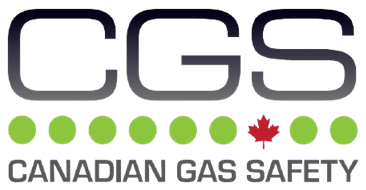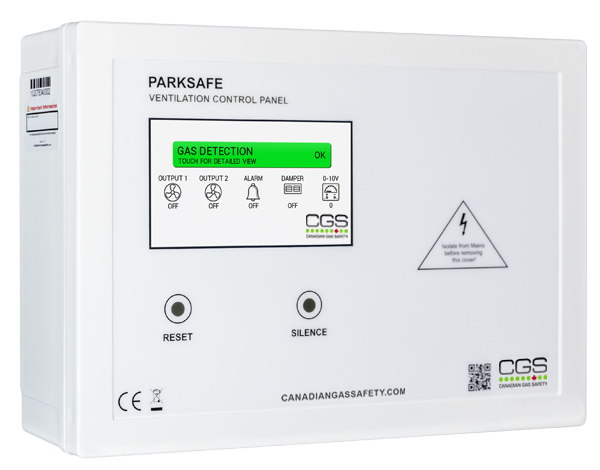CGS ParkSafe Flyer
CGS ParkSafe Brochure
CGS Brochure / Application Guide
CGS ParkSafe CAD – DWG File
CGS ParkSafe CAD – PDF File
ParkSafe From CGS
Gas Detection for Enclosed Parking Structures – UL Listed
The CGS ParkSafe is a UL Listed gas detection and ventilation control system developed to help you meet IMC 2021 404.1 requirements for enclosed parking garages.
It is designed to be paired with the CGS Nitrogen (NO2) and Carbon Monoxide (CO) gas detectors that can be linked via MODBUS back to the ParkSafe control panel, up to 16 gas detectors per panel can be used in any combination.
The ParkSafe controller can automatically drive ventilation dependent on the levels of gas detected through multiple outputs designed for on/off, two speed and variable fan systems.
The screen displays key information such as the live gas levels of each area, the type of gas & each output status, for example the 0-10V output driving the ventilation. The touchscreen display is also used to for installation purposes to give the technician quick & precise options to setup the ParkSafe controller.
Please contact Canadian Gas Safety or your local representative for further information.
- CGS ParkSafe Design Ideas
- CGS ParkSafe Specification & CAD Drawing
- CGS ParkSafe Control Panel
- CGS ParkSafe Gas Detector
- Code Requirement
CGS ParkSafe CAD – DWG File
CGS ParkSafe CAD – PDF File
Gas Detection System Enclosed Garage ParkSafe
CGS ParkSafe Controller User Manual EN – FR
CGS ParkSafe Spec Sheet
CGS ParkSafe Spec Sheet – French Canadian
CGS ParkSafe Detector User Manual EN – FR
CGSCOPS Spec Sheet
CGSCOPS Spec Sheet – French Canadian
CGSNO2PS Spec Sheet
CGSNO2PS Spec Sheet – French Canadian
NECB A-5.2.3.4(1) Enclosed Spaces Where Fuel-Powered Equipment is Used
Examples of enclosed spaces targeted by Sentence 5.2.3.4.(1) are indoor sports arenas where fuel-powered equipment is used for maintenance of the play area (such as an ice-surfacing vehicle in an ice-rink arena), warehouses with propane-fueled forklifts, and heated indoor storage garages. In such spaces, contaminant levels are often controlled through on-and-off staging of a dedicated fan system. However, some ventilation systems use variable-speed fans to modulate between a set minimum (which can be as low as 0 when the contaminant levels are low enough) and the peak airflow rates needed to control the levels of contaminants in the air. Air contaminants generally controlled by such systems are carbon monoxide (CO) and nitrous oxides (NOx), depending on the type of fuel used.
Spaces where fuel-powered vehicles or mobile fuel-powered equipment or appliances are used on a semi-continuous basis (e.g., multiple forklifts actively used in a distribution warehouse) may be exempted from complying with Sentence 5.2.3.4.(1), subject to the approval of the authority having jurisdiction. However, some standards, such as ANSI/ASHRAE 62.1, “Ventilation for Acceptable Indoor Air Quality,” still require a minimum ventilation rate based on occupancy or other activities carried out in the space. It is expected that a means will be provided to evacuate exhaust air from fixed fuel-powered appliances and equipment directly to the outdoors. Thus, only spaces where vehicles or mobile equipment or appliances with combustion engines are used are targeted by this requirement.
General
“Instead of providing constant airflow at peak design rates like traditional ventilation systems, demand control ventilation systems include strategies designed to modulate the minimum outdoor airflow rates required for some applications, based on a dynamic variable such as transient occupancy or vented process use.
Demand control ventilation is recognized as being an effective energy efficiency measure for certain applications and the strategies listed in Article 5.2.3.4. are deemed reliable. However, the effectiveness of other demand control ventilation strategies can vary significantly according to the application for which they are being used and their implementation, occupant density, and the type, placement and calibration of the sensor.
Most notably, the improper implementation of CO2-based demand control ventilation systems that modulate outdoor airflow rates to occupied spaces can lead to the over- or under-ventilation of the spaces, resulting in either excessive energy use or health and safety issues for the occupants. Thus, demand control ventilation strategies should be implemented in accordance with the latest best practices. See ASHRAE publications or other applicable documents for additional information.”
IMC 404.1 Enclosed Parking Garages
Mechanical ventilation systems for enclosed parking garages shall operate continuously or shall be automatically operated by means of carbon monoxide detectors applied in conjunction with nitrogen dioxide detectors. Such detectors shall be listed in accordance with UL 2075 and installed in accordance with their listing and the manufacturer’s instructions.


